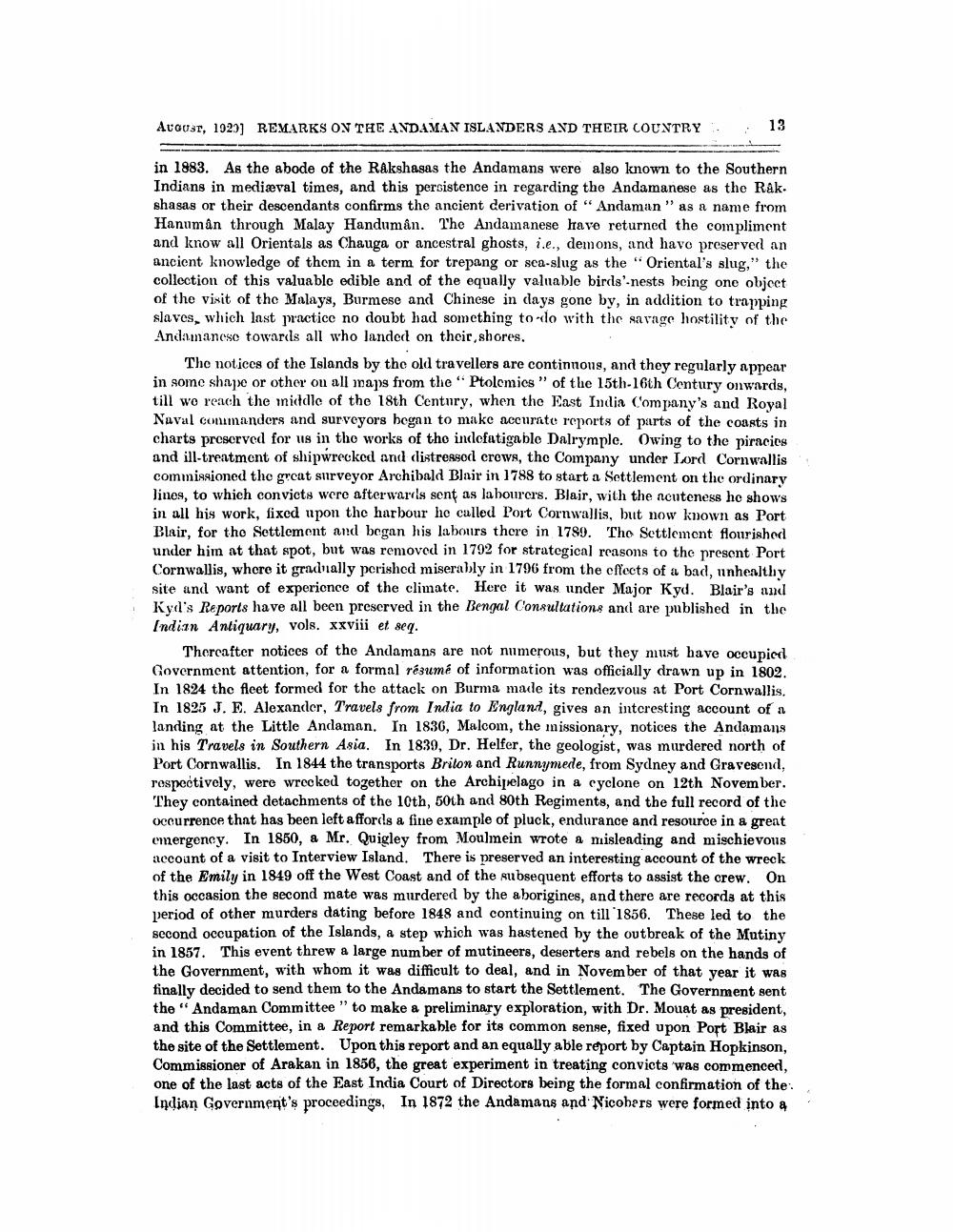________________
August, 1929) REMARKS ON THE ANDAMAN ISLANDERS AND THEIR COUNTRY.
13
in 1983. As the abode of the Rakshasas the Andamans were also known to the Southern Indians in mediæval times, and this persistence in regarding the Andamanese as the Rak. shasas or their descendants confirms the ancient derivation of " Andaman "as a name from Hanuman through Malay Handumân. The Andamanese have returned the compliment and know all Orientals as Chauga or ancestral ghosts, i.e., demons, and havo preserved an ancient knowledge of them in a term for trepang or sea-slug as the "Oriental's slug," the collection of this valuablo edible and of the equally valuable birds'-nests being one object of the visit of the Malays, Burmese and Chinese in days gone by, in addition to trapping slaves, which last practice no doubt had something to do with the savage hostility of the Andamaneso towards all who landed on their shores,
The notices of the Islands by the old travellers are continuous, and they regularly appear in some shape or other on all maps from the "Ptolcmies" of the 15th-16th Century onwards, till we reach the iniddle of the 18th Century, when the East India Company's and Royal Naval commanders and surveyors began to make accurate reports of parts of the coasts in charts preserved for us in the works of the indefatigablo Dalrymple. Owing to the piracics and ill-treatment of shipwrecked and distressod crows, the Company under Lord Cornwallis commissioned the great surveyor Archibald Blair in 1788 to start a Settlement on the ordinary lines, to which convicts were afterwar is sent as labourers. Blair, with the neuteness he shows in all his work, fixed upon the harbour ho called Port Cornwallis, but now known as Port Blair, for tho Settlement and began his labours there in 1789. Tho Settlement flourished under him nt that spot, but was removed in 1792 for strategical reasons to the present Port Cornwallis, where it gradually perished miserably in 1796 from the effects of a bad, unhealthy site and want of experience of the climate. Here it was under Major Kyd. Blair's and Kyd's Reports have all been preserved in the Bengal Consultations and are published in the Indian Antiquary, vols. xxviii et seq.
Thereafter notices of the Andamans are not numerous, but they must have occupied Government attention, for a formal résumé of information was officially drawn up in 1802. In 1824 the fleet formed for the attack on Burma made its rendezvous at Port Cornwallis. In 1825 J. E. Alexander, Travels from India to England, gives an interesting account of a landing at the Little Andaman. In 1836, Malcom, the missionary, notices the Andamans in his Travels in Southern Asia. In 1839, Dr. Helfer, the geologist, was murdered north of Port Cornwallis. In 1844 the transports Briton and Runnymede, from Sydney and Gravesend, respeótively, were wrecked together on the Archipelago in a cyclone on 12th November. They contained detachments of the 10th, 50th and 80th Regiments, and the full record of the occurrence that has been left affords a fine example of pluck, endurance and resource in a great emergency. In 1850, a Mr. Quigley from Moulmein wrote a misleading and mischievous account of a visit to Interview Island. There is preserved an interesting account of the wreck of the Emily in 1849 off the West Coast and of the subsequent efforts to assist the crew. On this occasion the second mate was murdered by the aborigines, and there are records at this period of other murders dating before 1848 and continuing on till '1856. These led to the second occupation of the Islands, a step which was hastened by the outbreak of the Mutiny in 1857. This event threw a large number of mutineers, deserters and rebels on the hands of the Government, with whom it was difficult to deal, and in November of that year it was finally decided to send them to the Andamans to start the Settlement. The Government sent the " Andaman Committee "to make a preliminary exploration, with Dr. Mouat as president, and this Committee, in a Report remarkable for its common sense, fixed upon Port Blair as the site of the Settlement. Upon this report and an equally able report by Captain Hopkinson, Commissioner of Arakan in 1856, the great experiment in treating convicts 'was commenced, one of the last acts of the East India Court of Directors being the formal confirmation of the Indian Government's proceedings, In 1872 the Andamans and Nicobers were formed into a




